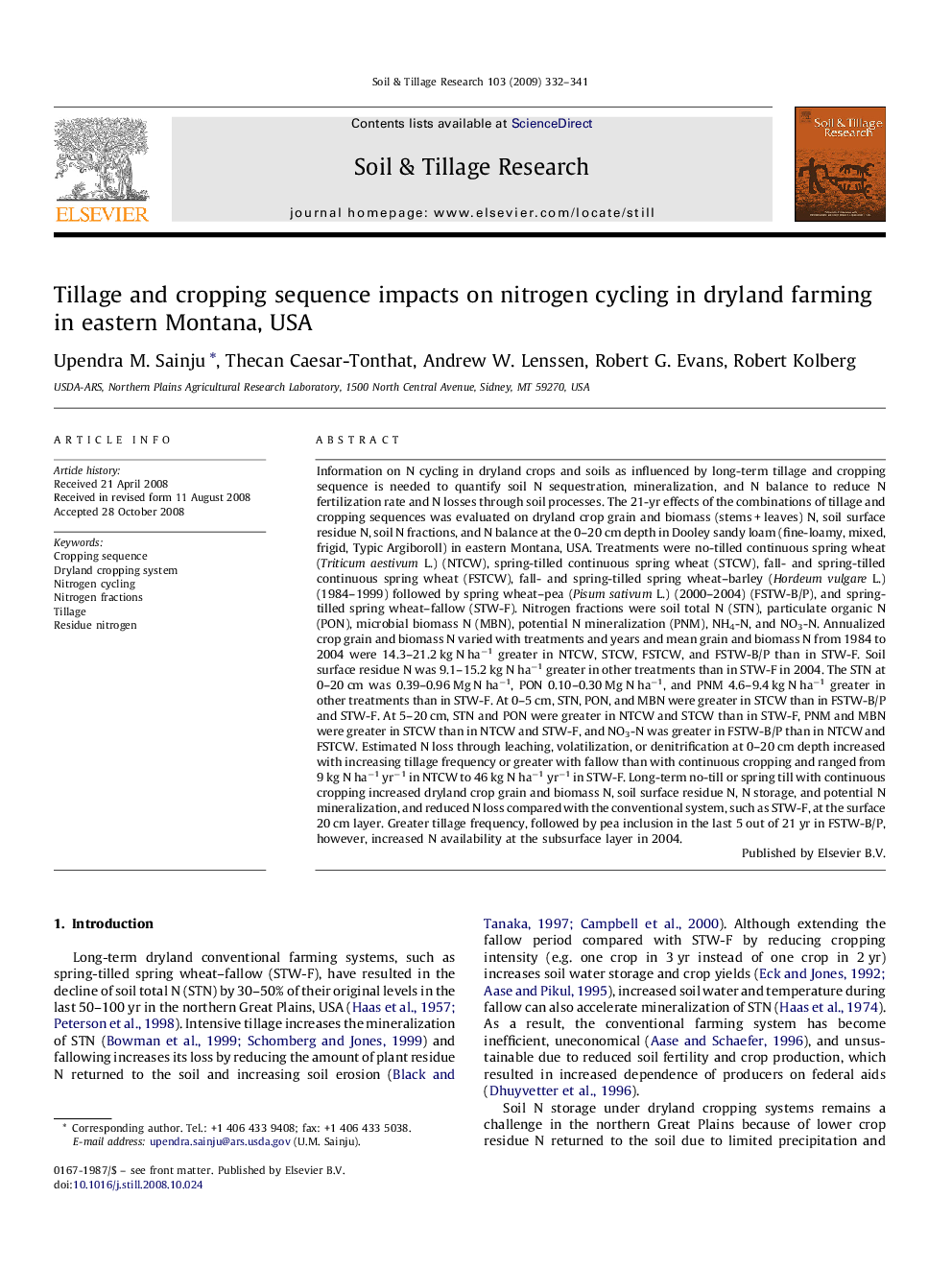| کد مقاله | کد نشریه | سال انتشار | مقاله انگلیسی | نسخه تمام متن |
|---|---|---|---|---|
| 306328 | 513090 | 2009 | 10 صفحه PDF | دانلود رایگان |

Information on N cycling in dryland crops and soils as influenced by long-term tillage and cropping sequence is needed to quantify soil N sequestration, mineralization, and N balance to reduce N fertilization rate and N losses through soil processes. The 21-yr effects of the combinations of tillage and cropping sequences was evaluated on dryland crop grain and biomass (stems + leaves) N, soil surface residue N, soil N fractions, and N balance at the 0–20 cm depth in Dooley sandy loam (fine-loamy, mixed, frigid, Typic Argiboroll) in eastern Montana, USA. Treatments were no-tilled continuous spring wheat (Triticum aestivum L.) (NTCW), spring-tilled continuous spring wheat (STCW), fall- and spring-tilled continuous spring wheat (FSTCW), fall- and spring-tilled spring wheat–barley (Hordeum vulgare L.) (1984–1999) followed by spring wheat–pea (Pisum sativum L.) (2000–2004) (FSTW-B/P), and spring-tilled spring wheat–fallow (STW-F). Nitrogen fractions were soil total N (STN), particulate organic N (PON), microbial biomass N (MBN), potential N mineralization (PNM), NH4-N, and NO3-N. Annualized crop grain and biomass N varied with treatments and years and mean grain and biomass N from 1984 to 2004 were 14.3–21.2 kg N ha−1 greater in NTCW, STCW, FSTCW, and FSTW-B/P than in STW-F. Soil surface residue N was 9.1–15.2 kg N ha−1 greater in other treatments than in STW-F in 2004. The STN at 0–20 cm was 0.39–0.96 Mg N ha−1, PON 0.10–0.30 Mg N ha−1, and PNM 4.6–9.4 kg N ha−1 greater in other treatments than in STW-F. At 0–5 cm, STN, PON, and MBN were greater in STCW than in FSTW-B/P and STW-F. At 5–20 cm, STN and PON were greater in NTCW and STCW than in STW-F, PNM and MBN were greater in STCW than in NTCW and STW-F, and NO3-N was greater in FSTW-B/P than in NTCW and FSTCW. Estimated N loss through leaching, volatilization, or denitrification at 0–20 cm depth increased with increasing tillage frequency or greater with fallow than with continuous cropping and ranged from 9 kg N ha−1 yr−1 in NTCW to 46 kg N ha−1 yr−1 in STW-F. Long-term no-till or spring till with continuous cropping increased dryland crop grain and biomass N, soil surface residue N, N storage, and potential N mineralization, and reduced N loss compared with the conventional system, such as STW-F, at the surface 20 cm layer. Greater tillage frequency, followed by pea inclusion in the last 5 out of 21 yr in FSTW-B/P, however, increased N availability at the subsurface layer in 2004.
Journal: Soil and Tillage Research - Volume 103, Issue 2, May 2009, Pages 332–341